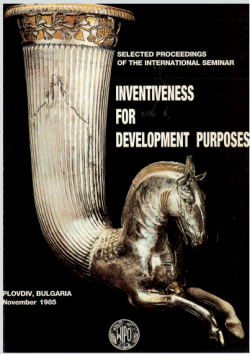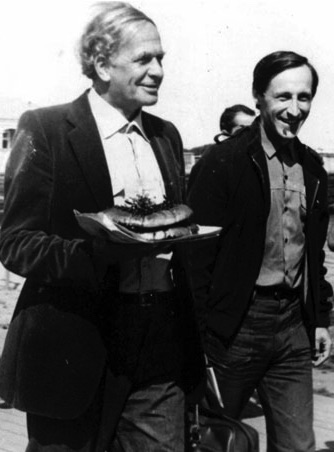 TRIZ Paper (1985, Narbut & Narbut) TRIZ Paper (1985, Narbut & Narbut) |

  |
From the Exchange of Inventions to the Exchange of Methods |
A. Narbut and N. Narbut (Soviet Union),
Selected Proceedings of the International Seminar: Inventiveness for Development Purposes (Plovdiv, Bulgaria, Nov. 12 - 15, 1985),
Published by WIPO (World Intellectual Property Organization), Geneve (1987). pp. 99 - 103
|
Contributed by Alexander Theodor Narbut (Ukraine), Nov. 13, 2023
Q&A: Q: Toru Nakagawa, A: Alexander T. Narbut, Nov. 19, 2023.
|
| Posted: Nov. 27, 2023 |
For going to Japanese pages, press  buttons.
buttons.
 Editor's Note (Toru Nakagawa, Nov. 23, 2023)
Editor's Note (Toru Nakagawa, Nov. 23, 2023)
In response to my message of the 25th Anniversary of "TRIZ Home Page in Japan", Alexander T. Narbut kindly contributed his paper presented in 1985. I understand the message of the paper, i.e.,"From the Exchange of Inventions to the Exchange of Methods", is important even at present, nearly after four decades. So I replied him my pleaseure to post it in my website, and asked him four questions about the background of his paper. He wrote thorough answers, after trying hard to make them brief.
The present page contains:
[A] Paper by A. Narbut & N. Narbut (1985), in .html. 
[B]
Selected Proceedings of the Seminar: including Preface, Table of selected papers, and the Paper by Narbut & Narbut, in .pdf (attached).  (PDF
(PDF  )
)
[C] Q&A about the background. Q: TN, A: A. Narbut, in .html. 
[D] Selected communications between the Author (A.T. Narbut) and TN.
in .html 
I am very grateful to Mr. Alexander T. Narbut for his support of my Website for a long time and his kind contribution, even at the present extremely severe period for his country, Ukraine.
 [A] Paper by A. Narbut & N. Narbut (1985)
[A] Paper by A. Narbut & N. Narbut (1985)
From the Exchange of Inventions to the Exchange of Methods
Mr. A. Narbut and Mrs. N. Narbut,
Researchers, Public Laboratory of Invention Theory,
Soviet Union
Selected Proceedings of the International Seminar: Inventiveness for Development Purposes
(organized by the
Government of the People's Republic of Bulgaria in cooperation with the
World Intellectual Property Organization (WIPO),
Plovdiv, Bulgaria, November 12 to 15, 1985),
Published by WIPO,
WIPO Publication No 655(E), ISBN 92-805-0176-3, WIPO, Geneve (1987). pp. 99 - 103.
Our colleagues engaged in elaborating or implementing inventions on a large scale cannot fail to have noted a very clear trend: ever more frequently, the international trade partners seek to acquire not a finished industrial product, but a secret or a method for producing it. The varying forms of trade in inventions are becoming more and more advantageous to the various partners. It is clear that such exchange of inventions actively contributes to speeding up the industrial development of those countries participating in the exchange. It is not necessary to give figures since these are widely known.
Why is it therefore that the overwhelming majority of inventions obtained originate in the industrially developed countries (particularly Japan) and why is it that the countries of the "Third World," the developing countries, make such little use of this effective means of strengthening their industry?
Analysis of this situation brings us to the following conclusion: the majority of modern inventions are intended for technical systems that are at a very high level. Consequently, their use in the relatively less advanced industry of developing countries is either altogether impossible or possible only after substantial prior adaptation, that is to say after the development of a new solution that corresponds to the level of the existing technical systems. In addition, the purchase of inventions (e.g. through licenses) frequently implies the purchase of the corresponding equipment from the other country and leads to a degree of dependency on that country.
In all those cases, the developing countries are forced to pay an excessively high price to develop their industry. The conclusion is obvious: if inventions are necessary to developing countries, but their purchase is not economically valid, it is therefore much more rational to "produce the inventions" directly within the country. Moreover, inventions should ideally occur at the exact place where the need is felt: within a specific factory, plant, scientific
establishment or farm. In other words, any country that wishes to become industrially developed has need of a system for producing inventions. The first step along the path to creating such a system must be to familiarize senior engineers with the principles of the modern theory on the solution of inventive problems (TSIP) [TRIZ].
The basic principle of this theory is the fact that the orientation of the development of technical systems is objective, that is to say it depends neither on our possibilities nor on our needs. Naturally, without man, technology cannot develop. Man speeds up or slows down the development of a given technical system, he creates new systems and abandons old ones. However, once he has begun with the development of a given system, development will proceed according to principles that are out of his control.
An analogy can be made between a technical system and a railway truck. A man can push a truck with all the strength he can muster, but the fastest movement will only be achieved if he pushes in the direction of the rails. So far, the analysis of tens of thousands of technical systems taken
from "real life" has enabled some ten basic laws to be established for their development. It has also been discovered that any technical system whatsoever can be modeled as a compact system comprising objects and fields. The simplest functional system may be comprised of two objects and one field.
The developers of TSIP [TRIZ] are continuing to collect information in order to give the abstract models and laws a practical technical content that takes into consideration the latest scientific achievements (particularly in physics) . The
laws of development, the object-field models and the information bank in turn enable structures to be set the inventive solution of real technical engineering problems. To return to the analogy of the railway, the development of a technical system may be represented as a railway line. The whole field of technology thus takes on the form of a railway network with a large number of branches. In order to solve an inventive problem it would be necessary, in such a model, to displace a "truck" from one track to another in order to reach the desired location whatever the point of departure.
At first glance, all is simple. However, there always exists an obstacle to the change of track. "Inventions are necessary for the development of industry, but inventions are not desired if one has to pay too much for them." That is more or less the situation any inventive problem is reduced to. To identify the basic obstacle to the development of a technical system using a given set of means to overcome the obstacle is a working principle that constitutes an important component of TSIP [TRIZ]: the algorithm for solving inventive problems (ASIP) [ARIZ].
With the aid of ASIP [ARIZ], problems can be resolved
progressively, step by step. Starting from an actual
situation, an abstract model is set up and the reciprocal action of the elements in the model is studied down to the contradictory physical requirements with respect to the condition or state of one of those elements.
In this context, allowance
is made for the fact that technical systems strive towards an ideal, as also other laws of development, and varying methods are used to overcome the contradictiions.
In some cases, rules have been derived from
well-known object-field models, enabling optimum decisions to be reached directly without a lengthy analysis (the so-called TSIP [TRIZ] standards). Mention should also be made of the importance of a course held on the development of creative imagination. It enables management of the psychological factors involved in the process of solving inventive problems.
Unfortunately, the time available for the lecture does not permit us to cite a sufficient number of examples of the use of the theory of solution of inventive problems (TSIP) [TRIZ]. Indeed, many inventions could be mentioned which have been developed with the aid of this theory, both in the Soviet Union and in other countries. In Bulgaria, for instance, a number of seminars have been devoted to studying this theory during recent years, a series of books has been published and quite a few inventions have been made with its aid.
However, the most important aspect, in our view, is not the number of inventions. The importance lies in the fact that TSIP [TRIZ] almost always leads to usable technical solutions whatever the problem involved. Additionally, the solution is compatible with the existing technical system. In other words, TSIP [TRIZ] can be used at all levels of production. And in every case the high quality of the solution is guaranteed as is its high degree of effectiveness. It is therefore already possible to state today that the exchange of inventions may be replaced by a wide-ranging exchange of the methods of obtaining inventions.
The Public Laboratory of Inventive Theory, which we have the honor to represent, has gathered a great deal of experience of such exchanges with colleagues from Bulgaria, the GDR, Poland, Viet Nam and other counties. Books by members of the Laboratory and by our scientific director Genrikh Altschuler have been translated in numerous countries throughout the world, including Japan, the USA and the United Kingdom. Training programs have been devised and tested, running from minimum introductory programs to fundamental programs involving two years of continuous training. We are willing to provide any assistance to public establishments or to individual enterprises in any country, either through the intermediary of WIPO or on the basis of bilateral agreements. We are convinced that such activities, which correspond fully with the aims of this seminar, will be useful for everyone.
 [B] Selected Proceedings of the International Seminar (PDF)
[B] Selected Proceedings of the International Seminar (PDF)
Selected Proceedings of the International Seminar: Inventiveness for Development Purposes
(organized by the Government of the People's Republic of Bulgaria in cooperation with the World Intellectual Property Organization (WIPO), Plovdiv, Bulgaria, November 12 to 15, 1985),
Published by WIPO, WIPO Publication No 655(E), ISBN 92-805-0176-3, WIPO, Geneve (1987).
==> PDF  (Foreward, Table of Contents, Paper by Narbut & Narbut) (Foreward, Table of Contents, Paper by Narbut & Narbut) |
|
 |
 [C] Q&A about the background of the paper
[C] Q&A about the background of the paper
Q (TN): Your paper is compact and clear even at present, after 4 decades. Is it possible for you to make brief explanations about the situations at that time?
A (A.T. Narbut): You have raised good questions, but they are difficult to answer briefly — because every word needs serious evidence.
Q1 (TN): How was "Public Laboratory of Invention Theory" organized and working in those days? What roles were you playing in it?
A1 (A.T. Narbut): G.S. Altshuller started to create the "Public Laboratory of the Theory of Invention" in 1975. Before that, the "Public Laboratory of Invention Methodology" was working for several years, which was created together with the officials of the USSR (more precisely, the All-Union Society of Inventors and Rationalizers).
I began studying with G.S. Altshuller in 1975, but within a few months our group began to participate in research work (solving test tasks, forming information funds, analyzing science fiction, etc.). In 1977, on the recommendation of G.S. Altshuller, our group opened its own TRIZ school — initially for the Zaporizhzhia region, and from 1980 for the whole of Ukraine. At the same time, our group participated in more in-depth research — in particular, in the development of ARIZ and in the development of creative personalities and creative teams.
In 1979, G.S. Altshuller raised the level of requirements for articles published on behalf of the Public Laboratory of the Theory of Invention. Since then, all articles have been reviewed and received a personal number. The first number on this list is the article "Creativity and worldview" (philosophical foundations of TRIZ, authors — Natalia Narbut and Aleksandr Narbut). The following year, this article (in an abbreviated form) was printed in the magazine "Technology and Science"— along with the article by G.S. Altshuller.
In 1987, the Polish Academy of Sciences published the book "Design Research in Progress". This book included brief descriptions of more than 150 studies on creativity and invention in the world. About a third of these studies were associated with the Public Laboratory of the Theory of Invention. Among them, three studies conducted by our group under the leadership of G.S. Altshuller were presented (please, see attached file).
Our group actively cooperated with G.S. Altshuller from 1975 to 1998, and then for several more years we helped V. N. Zhuravliova in the work on the "Fund-Archive".
Q2 (TN): I notice Mr. Altshuller declared in summer 1985 that he was going to move from research in (technological) TRIZ methods to the research of creative personality. How was your paper related to this shift?
A2 (A.T. Narbut): Unfortunately, I cannot confirm your words that "Mr. Altshuller declared in summer 1985 that he was going to move from research in (technological) TRIZ methods to the research of creative personality." Creative personality research was actively conducted in the 1970s (our group took part in it). On the other hand, the development of ARIZ did not stop in 1985. For example, the ARIZ-85V version was published in 1989 — and it is very different from the 1985 version.
Problems in the development of TRIZ, which began in 1989, are problems of internal instability in the USSR. For example, the post office stopped working normally (due to military conflicts in certain regions) and wide scientific communication became almost impossible for a long time. It was possible to conduct separate, local studies, but it was not possible to combine the efforts of several hundred schools (as was the case in the early 80s).
Q3 (TN): At the Seminar, two official persons from USSR gave papers besides you. How was the relationship of TRIZ group with them?
A3 (A.T. Narbut): I had no contact with "two official persons from the USSR". I had good relations with some officials in the space industry and atomic science. By the way, we are currently continuing active cooperation with such specialists in Ukraine and some friendly countries. Also, many TRIZ specialists in Ukraine work at defense industry enterprises. It is very important for us right now.
Q4 (TN): How was your paper accepted by the audience of the Seminar?
A4 (A.T. Narbut): In 1985, I could not come to Bulgaria. But, apparently, the text of the report was liked by the organizers — and they chose it for their book. This book was published in the autumn of 1987 (in Geneva, Switzerland), and the very next year I received an invitation to participate in a scientific conference in Bulgaria. Also in 1988 I held several TRIZ seminars for companies in Bulgaria and Hungary, then I was invited to Poland and Germany... I think the WIPO seminar was an important element of this process.
 [D] (Selected) Communications between the Author (Alexander T. Narbut) and Toru Nakagawa
[D] (Selected) Communications between the Author (Alexander T. Narbut) and Toru Nakagawa
 (a) TN ==> HP readers Nov. 13, 2023 "TRIZ Home Page in Japan" Updated
(a) TN ==> HP readers Nov. 13, 2023 "TRIZ Home Page in Japan" Updated
25th Anniversary of "TRIZ Home Page in Japan"
 (b) Alexander T. Narbut (Ukraine) ==> TN Nov. 14, 2023
(b) Alexander T. Narbut (Ukraine) ==> TN Nov. 14, 2023
Dear Professor,
Thank you for your letter and thank you for your long work for TRIZ.
Unfortunately, I can't write much for a "wide audience" right now. The people of Ukraine are fighting for their freedom and we are grateful to the people of Japan for their support and help.
But I have an old article on the use of TRIZ (TSIP) that was first in WIPO publications. G.S. Altshuller was the editor of this article.
You can use it for your site.
Best regards!
Alexander Theodor Narbut.
 (c) TN ==> Alexander T. Narbut Nov. 14, 2023
(c) TN ==> Alexander T. Narbut Nov. 14, 2023
Dear Alexander, Thank you very much for your message and your support to my work.
I have just read through your paper presented at a WIPO Seminar in 1985. Your paper is compact and clear even at present, after 4 decades.
I am happy to post it in my Website. Is it possible for you to make brief explanations about the situations at that time? Four questions ==> See (C) Q1 to Q4 
We sincerely pray for you and the people of your country, during this extremely hard time.
Best wishes,
Toru
 (d) Alexander T. Narbut ==> TN Nov. 19, 2023
(d) Alexander T. Narbut ==> TN Nov. 19, 2023
You have raised good questions, but they are difficult to answer briefly — because every word needs serious evidence.
==> See Four Answers (C) A1 to A4 
| |
I tried very hard to write briefly. Perhaps you have some other questions — I can answer in addition.
It is also possible that you will be interested in some documents from the TRIZ archive (for example, we managed to save the letters of G.S. Altshuller, his information and letters of colleagues).
Sorry for the poor quality translation— forced to rush and forced to entrust the translation to the computer...
Best regards! Alexander.
|
|

G.S.Altshuller and A.T.Narbut.
Karelia (USSR), summer 1982.
|
 (e) TN ==> Alexander T. Narbut Nov. 20, 2023
(e) TN ==> Alexander T. Narbut Nov. 20, 2023
Thank you very much for your thorough explanations.
I will work on the article to post in my website as quickly as possible.
Best wishes, Toru
Last updated on Nov. 27, 2023 Access point: Editor: nakagawa@ogu.ac.jp

